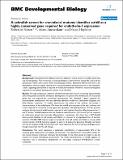A zebrafish screen for craniofacial mutants identifies wdr68as a highly conserved gene required for endothelin-1 expression
Author(s)
Nissen, Robert M.; Amsterdam, Adam; Hopkins, Nancy H.
Download1471-213X-6-28.pdf (1.715Mb)
PUBLISHER_CC
Publisher with Creative Commons License
Creative Commons Attribution
Terms of use
Metadata
Show full item recordAbstract
Background: Craniofacial birth defects result from defects in cranial neural crest (NC) patterning and morphogenesis. The vertebrate craniofacial skeleton is derived from cranial NC cells and the patterning of these cells occurs within the pharyngeal arches. Substantial efforts have led to the identification of several genes required for craniofacial skeletal development such as the endothelin-1 (edn1) signaling pathway that is required for lower jaw formation. However, many essential genes required for craniofacial development remain to be identified. Results: Through screening a collection of insertional zebrafish mutants containing approximately 25% of the genes essential for embryonic development, we present the identification of 15 essential genes that are required for craniofacial development. We identified 3 genes required for hyomandibular development. We also identified zebrafish models for Campomelic Dysplasia and Ehlers-Danlos syndrome. To further demonstrate the utility of this method, we include a characterization of the wdr68 gene. We show that wdr68 acts upstream of the edn1 pathway and is also required for formation of the upper jaw equivalent, the palatoquadrate. We also present evidence that the level of wdr68 activity required for edn1 pathway function differs between the 1st and 2nd arches. Wdr68 interacts with two minibrain-related kinases, Dyrk1a and Dyrk1b, required for embryonic growth and myotube differentiation, respectively. We show that a GFP-Wdr68 fusion protein localizes to the nucleus with Dyrk1a in contrast to an engineered loss of function mutation Wdr68-T284F that no longer accumulated in the cell nucleus and failed to rescue wdr68 mutant animals. Wdr68 homologs appear to exist in all eukaryotic genomes. Notably, we found that the Drosophila wdr68 homolog CG14614 could substitute for the vertebrate wdr68 gene even though insects lack the NC cell lineage. Conclusion: This work represents a systematic identification of approximately 25% of the essential genes required for craniofacial development. The identification of zebrafish models for two human disease syndromes indicates that homologs to the other genes are likely to also be relevant for human craniofacial development. The initial characterization of wdr68 suggests an important role in craniofacial development for the highly conserved Wdr68-Dyrk1 protein complexes.
Date issued
2006-06Department
Massachusetts Institute of Technology. Department of Biology; Koch Institute for Integrative Cancer Research at MIT; Koch Institute for Integrative Cancer Research at MITJournal
BMC Developmental Biology
Publisher
BioMed Central Ltd
Citation
BMC Developmental Biology. 2006 Jun 07;6(1):28
Version: Final published version
ISSN
1471-213X